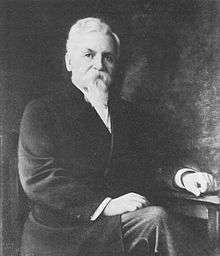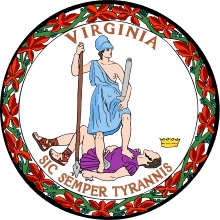William Hodges Mann
| William Hodges Mann | |
|---|---|
 | |
| 46th Governor of Virginia | |
|
In office February 10, 1910 – February 1, 1914 | |
| Lieutenant | James Taylor Ellyson |
| Preceded by | Claude A. Swanson |
| Succeeded by | Henry Carter Stuart |
| Member of the Virginia Senate from the 28th district | |
|
In office December 6, 1899 – January 12, 1910 | |
| Preceded by | Robert Turnbull |
| Succeeded by | John J. Owen |
| Personal details | |
| Born |
William Hodges Mann July 30, 1843 Williamsburg, Virginia, U.S. |
| Died |
December 12, 1927 (aged 84) Petersburg, Virginia, U.S. |
| Political party | Democratic |
| Spouse(s) |
Sallie Fitzgerald |
| Profession | Politician, Lawyer |
| Military service | |
| Allegiance |
|
| Service/branch |
|
| Rank | private |
| Unit | 12th Virginia Infantry |
| Battles/wars | Battle of Seven Pines |
William Hodges Mann (July 30, 1843 – December 12, 1927) was a Virginia lawyer, Confederate soldier and Democratic politician who became the first judge of Nottoway County, Virginia and the last Confederate veteran to serve as the 46th Governor of Virginia (from 1910 to 1914).[1]
Early and family life
Born in Williamsburg, Virginia on July 30, 1843 to John and Mary Hunter Bowers Mann. He had an older brother, Edwin Murray Mann (1840-1885) who was born in Delaware County, New York and who would also become a Virginia judge, but in Petersburg after the American Civil War discussed below. Their father died and mother remarried, to a man named Trotter, whom she survived, dying in 1893. William Mann attended Brownsburg Academy, a private Presbyterian high school in Brownsburg, Rockbridge County, Virginia in the Shenandoah Valley.[2]
He would marry twice, first to Sallie Fitzgerald Mann (1845–1882) and later to Etta Edloe Donnan Mann (1861–1960), who would bear sons Stuart Donnan Mann (1886–1889) and William Hodges Mann (1890–1953).[3]
American Civil War
When he was sixteen, Mann became Deputy Clerk of Nottoway County, Virginia in Southside Virginia. He left to enlist as a private in the 12th Virginia Infantry during the Civil War. He served as a scout in operations around Petersburg, and was captured by Union forces in 1863, but escaped, and served again until he was badly injured during the Battle of Seven Pines.[4] Upon partially recovering from his wounds, Mann resumed his office as Deputy Clerk in Nottoway County, as well as served the Confederacy in various positions.
Postwar career
After General Lee's surrender at Appomattox Court House, Mann read law. He began practicing law in Nottoway County in 1867, and became involved in Democratic Party politics, eventually with what became known as the Martin Organization organized by future U.S. Senator Thomas Staples Martin. In 1890, the Virginia General Assembly elected Mann judge of Nottoway County. However, his judicial career proved brief.

Voters from Nottaway County, together with those from adjacent Lunenburg and Brunswick Counties elected Mann to represent them in the Virginia Senate in 1899, and re-elected him several times, although after the 1900 census and 1902 State Constitutional Convention redistricting, the state senatorial district (now numbered the 28th) was redrawn to include not only Nottoway and Lunenburg Counties, but Amelia, Prince Edward and Cumberland Counties instead of Brunswick County (which was put into the 25th District along with Mecklenburg County and represented by F.B. Roberts).[5] (Mann's Senate predecessor, Robert Turnbull, was also a lawyer and would be elected clerk of Brunswick County in 1901 and later to the U.S. Congress). Senator Mann became chairman of the committee to revise Virginia Laws. In 1906 he introduced legislation to construct 450 high schools in Virginia, the most progressive educational funding to that date. Mann also favored Prohibition, but only at the state level; the "Mann Law" he authored closed about 800 saloons in counties lacking police protection.[6]
Mann was elected Virginia's governor in 1909 with 63.35% of the vote, defeating Republican William P. Kent and Socialist Labor candidate A.H. Dennitt. Upon taking office in January 1910, Mann became the last Confederate soldier to serve as Governor of Virginia. Governor Mann continued to advocate temperance and public education.[7] During his governorship, Mann refused to prevent the execution of the teen-aged Virginia Christian, a black house maid who was convicted of murdering her white employer, and the subject of a nationwide campaign for clemency.[8]
In 1911, Mann shook hands with President William Howard Taft as part of the Manassas Peace Jubilee marking the 50th anniversary of the First Battle of Bull Run.
Later years and death
Upon leaving office in 1910, Mann returned to his legal practice in Nottoway County and continued active in the Democratic Party. He died on December 12, 1927, aged 84, survived by his second wife (who died in 1960) and son William Hodges Mann (1890-1953), who had become a lawyer and would serve as Petersburg's mayor. Governor Mann was buried in what became the family plot at historic Blandford Cemetery in Petersburg.[9] The Library of Virginia has his gubernatorial papers.[10]
References
- ↑ http://www.nga.org/portal/site/nga/menuitem.29fab9fb4add37305ddcbeeb501010a0/?vgnextoid=201688fcf34e5010VgnVCM1000001a01010aRCRD Biography] by the National Governors Association
- ↑ www.markerhistory.com/brownsburg-marker-a-70
- ↑ https://www.findagrave.com/memorial/7140828
- ↑ Roslyn Reams Luther and Edwin C. Luter III, Governors of Virginia 1776-1974 (Accomac, Virginia: Eastern Shore News 1974) p. 91
- ↑ Cynthia Miller Leonard, Virginia's General Assembly 1619-1978 (Richmond, Virginia State Library 1978) pp. 572, 580, 584, 588
- ↑ Luther & Luther
- ↑ Luther & Luther
- ↑ https://www.virginiamemory.com/online-exhibitions/items/show/1069
- ↑ findagrave.com nos. 7140828 and 40657605.
- ↑ http://ead.lib.virginia.edu/vivaxtf/view?docId=lva/vi03142.xml A Guide to the Executive Papers of Governor William Hodges Mann, 1910-1914
- Larson, William (1982). Edward Younger, ed. The Governors of Virginia, 1860-1978. University Press of Virginia. pp. 159–169. ISBN 0-8139-0920-1.
| Political offices | ||
|---|---|---|
| Preceded by Claude A. Swanson |
Governor of Virginia 1910–1914 |
Succeeded by Henry Carter Stuart |
